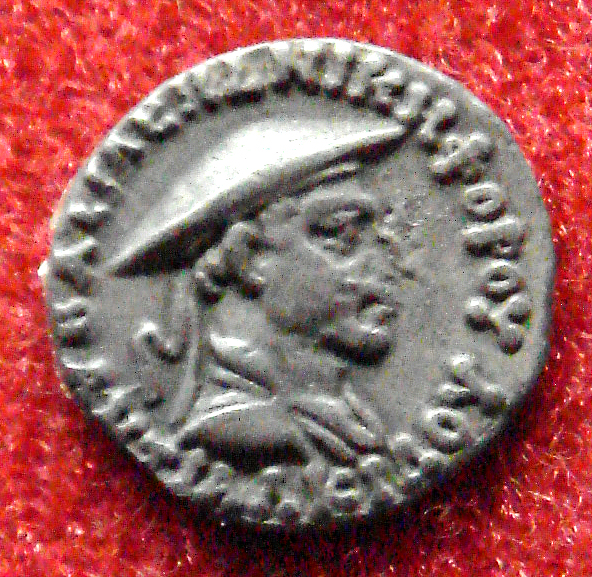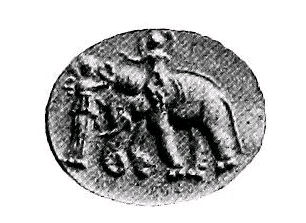Antialkidas on:
[Wikipedia]
[Google]
[Amazon]
 Antialcidas Nikephoros ( grc, Ἀντιαλκίδας ὁ Νικηφόρος; epithet means "the Victorious",
Antialcidas Nikephoros ( grc, Ἀντιαλκίδας ὁ Νικηφόρος; epithet means "the Victorious",
 Though there are few sources for the late Indo-Greek history, Antialcidas is known from an inscription left on a pillar (the
Though there are few sources for the late Indo-Greek history, Antialcidas is known from an inscription left on a pillar (the
Shane Wallace, 2016, p.222-223 A part of the inscription says: :"This Garuda-standard was made by order of the Bhagavata ... Heliodoros, the son of Dion, a man of Taxila, a Greek ambassador from King Antialkidas, to King Bhagabhadra, the son of the Princess from Benares, the saviour, while prospering in the fourteenth year of his reign."

 There is a bronze which features the obverse of
There is a bronze which features the obverse of
File:Antialkidas with Zeus giving wreath of victory to elephant.jpg, Antialkidas with Zeus directly giving wreath of victory to the elephant. With Greek legend ΒΑΣΙΛΕΩΣ ΝΙΚΗΦΟΡΟΥ ΑΝΤΙΑΛΚΙΔΟΥ "Of Victorious King Antialcidas"
Coins of Antialcidas
{{DEFAULTSORT:Antialcidas Indo-Greek kings 1st-century BC rulers in Asia 2nd-century BC rulers in Asia
 Antialcidas Nikephoros ( grc, Ἀντιαλκίδας ὁ Νικηφόρος; epithet means "the Victorious",
Antialcidas Nikephoros ( grc, Ἀντιαλκίδας ὁ Νικηφόρος; epithet means "the Victorious", Brahmi
Brahmi (; ; ISO: ''Brāhmī'') is a writing system of ancient South Asia. "Until the late nineteenth century, the script of the Aśokan (non-Kharosthi) inscriptions and its immediate derivatives was referred to by various names such as 'lath' ...
: 𑀅𑀁𑀢𑀮𑀺𑀓𑀺𑀢𑀲 ''Aṃtalikitasa'', in the Heliodorus Pillar
The Heliodorus pillar is a stone column that was erected around 113 BCE in central India in Besnagar (near Vidisha, Madhya Pradesh). The pillar was called the ''Garuda-standard'' by Heliodorus, referring to the deity Garuda. The pillar is commonly ...
) was a king of the Indo-Greek Kingdom
The Indo-Greek Kingdom, or Graeco-Indian Kingdom, also known historically as the Yavana Kingdom (Yavanarajya), was a Hellenistic-era Greek kingdom covering various parts of Afghanistan and the northwestern regions of the Indian subcontinent (p ...
, who reigned from his capital at Taxila. Bopearachchi has suggested that he ruled from ca. 115 to 95 BCE in the western parts of the Indo-Greek realms, whereas R. C. Senior places him around 130 to 120 BCE and also in eastern Punjab
Punjab (; Punjabi: پنجاب ; ਪੰਜਾਬ ; ; also romanised as ''Panjāb'' or ''Panj-Āb'') is a geopolitical, cultural, and historical region in South Asia, specifically in the northern part of the Indian subcontinent, comprising a ...
(which seems better supported by coin findings). Senior does however believe that he ruled in tandem with King Lysias.
Genealogy
Antialcidas may have been a relative of theGreco-Bactrian
The Bactrian Kingdom, known to historians as the Greco-Bactrian Kingdom or simply Greco-Bactria, was a Hellenistic-era Greek state, and along with the Indo-Greek Kingdom, the easternmost part of the Hellenistic world in Central Asia and the India ...
king Heliocles I
Heliocles I ( grc, Ἡλιοκλῆς, Helioklēs; reigned 145–120 BCE) was a Greco-Bactrian king, brother and successor of Eucratides the Great, and considered (along with his co-ruler and son/nephew Heliocles II) the last Greek king to reign ...
, but ruled after the fall of the Greco-Bactrian kingdom. Several later kings may have been related to Antialcidas: Heliokles II
Heliocles II Dicaeus (Greek language, Greek: ; epithet means "the just") is thought to have been one of the later Indo-Greek kings and a relative of the Bactrian king Heliocles I. Current scholarly consensus is that he ruled ca 95–80 BCE.
He ...
, Amyntas, Diomedes and Hermaeus all struck coins with similar features.
The Heliodorus inscription
 Though there are few sources for the late Indo-Greek history, Antialcidas is known from an inscription left on a pillar (the
Though there are few sources for the late Indo-Greek history, Antialcidas is known from an inscription left on a pillar (the Heliodorus pillar
The Heliodorus pillar is a stone column that was erected around 113 BCE in central India in Besnagar (near Vidisha, Madhya Pradesh). The pillar was called the ''Garuda-standard'' by Heliodorus, referring to the deity Garuda. The pillar is commonly ...
), which was erected by his ambassador Heliodorus at the court of the Shunga
is a type of Japanese erotic art typically executed as a kind of ukiyo-e, often in woodblock print format. While rare, there are also extant erotic painted handscrolls which predate ukiyo-e. Translated literally, the Japanese word ''shunga' ...
king Bhagabhadra
Bhagabhadra ( Brāhmī: 𑀪𑀸𑀕𑀪𑀤𑁆𑀭 , ) was one of the kings of the Indian Shunga dynasty. He ruled in north, central India around from 114 BCE to 83 BCE. Although the capital of the Shungas was at Pataliputra, he was also known ...
at Vidisha
Vidisha (विदिशा, formerly known as Bhelsa and known as Besnagar in ancient times) is a city in central Madhya Pradesh, India. It is located 62.5 km northeast of the state capital, Bhopal. The name "Vidisha" is derived from th ...
, near Sanchi
Sanchi is a Buddhist complex, famous for its Great Stupa, on a hilltop at Sanchi Town in Raisen District of the State of Madhya Pradesh, India. It is located, about 23 kilometres from Raisen town, district headquarter and north-east of Bh ...
. It states that he was a devotee of Vishnu, the Hindu god.Greek Culture in Afghanistan and India: Old Evidence and New DiscoveriesShane Wallace, 2016, p.222-223 A part of the inscription says: :"This Garuda-standard was made by order of the Bhagavata ... Heliodoros, the son of Dion, a man of Taxila, a Greek ambassador from King Antialkidas, to King Bhagabhadra, the son of the Princess from Benares, the saviour, while prospering in the fourteenth year of his reign."
Coins
Otherwise, Antialcidas is also known through his plentiful coins. He issued a number of bilingual Indian silver types: diademed, wearing a helmet with bull's horns or a flat kausia. He also appears throwing a spear. According to some interpretations (Grousset), the baby elephant may symbolize the BuddhaSiddhartha Gautama
Siddhartha Gautama, most commonly referred to as the Buddha, was a wandering ascetic and religious teacher who lived in South Asia during the 6th or 5th century BCE and founded Buddhism.
According to Buddhist tradition, he was born in Lu ...
, who took the shape of a small elephant to enter the womb of his mother Queen Maya
Queen Māyā of Shakya ( sa, मायादेवी, pi, Māyādevī) was the birth mother of Gautama Buddha, the sage on whose teachings Buddhism was founded. She was sister of Mahāpajāpatī Gotamī, the first Buddhist nun ordained by the ...
, a scene often depicted in Greco-Buddhist art. In that case the coin scene would represent a victory of Buddhism. According to other interpretations the elephant was the symbol of the city of Taxila.
"Mule coins" (overstrikes)

 There is a bronze which features the obverse of
There is a bronze which features the obverse of Lysias
Lysias (; el, Λυσίας; c. 445 – c. 380 BC) was a logographer (speech writer) in Ancient Greece. He was one of the ten Attic orators included in the "Alexandrian Canon" compiled by Aristophanes of Byzantium and Aristarchus of Samothrace i ...
and the reverse of Antialcidas. This was interpreted by Tarn and other earlier scholars as though the two kings might have forged some kind of alliance, but later, a bronze with the opposite arrangement was found.
Modern scholarship has however largely accepted that what was originally supposed to be a "joint issue" was in fact a mule; in other words, a mistake occurred in the process of overstriking the original coin, and it was accidentally issued with both king's standards.
References
Sources
* ''The Shape of Ancient Thought. Comparative studies in Greek and Indian Philosophies'' by Thomas McEvilley (Allworth Press and the School of Visual Arts, 2002) * ''Buddhism in Central Asia'' by B. N. Puri (Motilal Banarsidass, January 1, 2000) * ''The Greeks in Bactria and India'', W. W. Tarn, Cambridge University Press. * ''The Indo-Greeks'', A. K. Narain, B.R Publications * ''The Decline of the Indo-Greeks'', R. C. Senior & D. MacDonald, the Hellenistic Numismatic SocietyExternal links
Coins of Antialcidas
{{DEFAULTSORT:Antialcidas Indo-Greek kings 1st-century BC rulers in Asia 2nd-century BC rulers in Asia